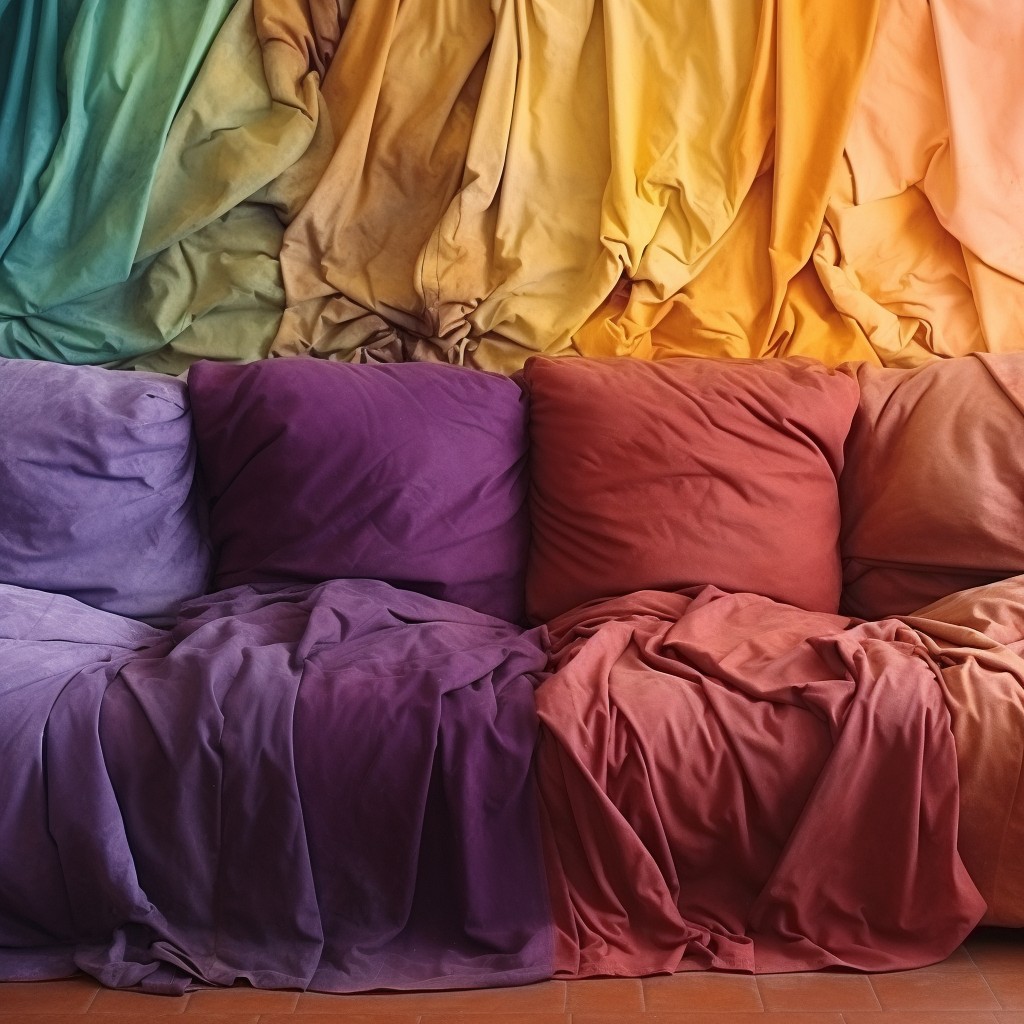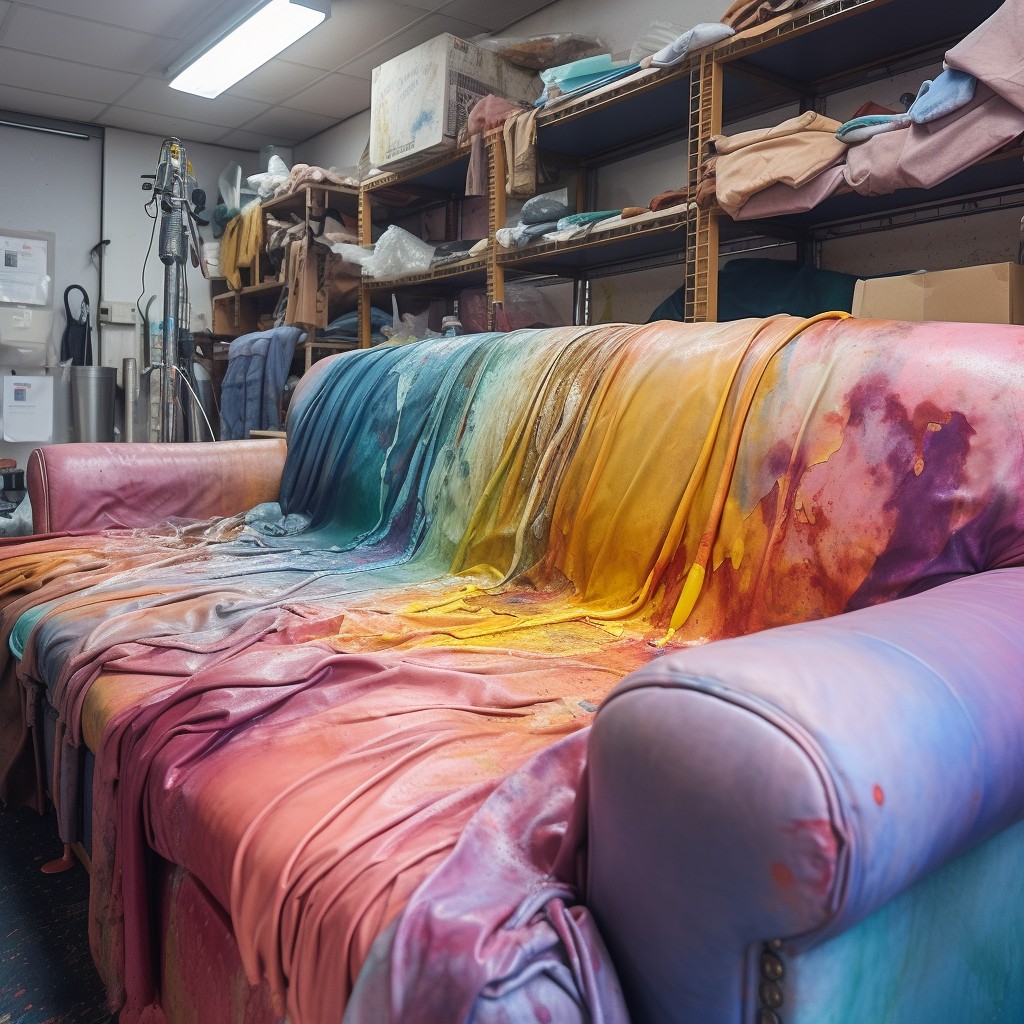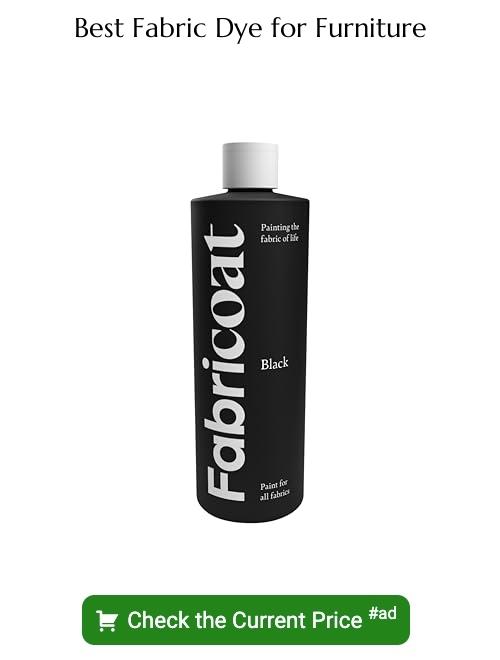Last updated on
Discover the transformative power of dyeing your couch as we guide you through a simple, cost-effective process to give your living space a fresh new look.
Have you ever looked at your old couch and wished it had a different color? Maybe you’ve moved into a new place and the color of your couch just doesn’t match the decor. Or perhaps, you’ve found a great deal on a used couch, but it’s not quite the right shade for your living room.
Whatever the reason may be, you might be wondering if it’s possible to dye a couch. In this article, we’ll explore whether or not dyeing a couch is an option and what factors to consider before taking on this DIY project.
So grab your favorite beverage and let’s dive in!
Table of Contents
Why Would I Want to Dye a Sofa?

Dyeing your couch can also be an excellent solution if you’ve inherited or purchased used furniture that doesn’t match the rest of your decor. It’s also perfect for those who love DIY projects and enjoy customizing their home furnishings.
Dyeing a sofa allows you to experiment with different colors and patterns, giving you more control over how your living room looks. You can choose from various shades and hues that complement or contrast with other elements in the room such as curtains, rugs, walls, etc.
Moreover, dyeing is not just limited to changing colors; it can help restore faded upholstery by bringing back its original vibrancy. This process works best on natural fabrics like cotton or linen but may work on synthetic materials too depending on their composition.
Types of Couch Fabrics

Not all fabrics are created equal and some may not take dye as well as others. The most common types of couch fabrics include cotton, linen, wool, leather and synthetic materials such as polyester or microfiber.
Cotton is a popular choice for upholstery due to its durability and breathability. It’s also easy to clean which makes it ideal for families with children or pets.
However, cotton can be difficult to dye evenly because it absorbs color differently in different areas.
Linen has a similar texture and feel like cotton but tends to wrinkle more easily than other fabrics. Linen can be dyed successfully but requires special care during the process since it’s prone to shrinkage.
Wool is another natural fiber that’s commonly used in upholstery due its softness and warmth retention properties. Wool takes dyes well but requires careful handling during cleaning since excessive agitation can cause felting (matting) of fibers.
Leather sofas are known for their luxurious look and feel; however they cannot be dyed using traditional methods because leather does not absorb liquid dyes like fabric does. Synthetic materials such as polyester or microfiber have become increasingly popular over the years due their affordability compared with natural fibers; however they tend not hold up quite so well under heavy use when compared with natural fibres.
Choosing a Suitable Dye

Not all dyes are created equal and some may not work well with certain fabrics or colors. Before you start your project, consider the fabric of your couch and what color you want to achieve.
For natural fibers like cotton or linen, fiber reactive dyes are a good choice as they bond directly with the fabric molecules for long-lasting results. Acid dyes work best on wool or silk while polyester requires special disperse dyes that can withstand high temperatures.
In addition to considering the type of fabric, think about what color you want to achieve. If you’re looking for a darker shade than your current sofa color, choose a dye that’s darker than what you need as it will lighten during application.
Ultimately, selecting an appropriate upholstery dye depends on several factors such as material composition and desired outcome.
Upholstery Dyeing Methods

There are three main methods for applying upholstery dye: using a paintbrush, spray bottle or continuous sprayer.
The paintbrush method involves dipping a brush into the prepared dye mixture and painting it onto the fabric in even strokes. This method is best suited for smaller areas of fabric or intricate designs that require precision.
The spray bottle method involves mixing the prepared dye with water in a spray bottle and misting it over larger sections of fabric. This technique allows for more even coverage but can be messy if not done carefully.
There’s the continuous sprayer method which uses an electric pump to apply an even coat of dyed solution across large surfaces quickly. It requires less effort than other methods but may not provide as much control over where exactly you want to apply color on your sofa.
Selecting a Sofa to Dye
First and foremost, the fabric of your couch is crucial. Not all fabrics can be dyed successfully, so it’s important to choose one that will take the dye well.
Natural fibers such as cotton or linen tend to absorb dyes better than synthetic materials like polyester or nylon. However, some synthetic blends may also work well with certain types of dyes.
Another factor you should consider is the color of your current couch. If you’re looking for a drastic change in color (e.g., going from dark brown leather to light blue), keep in mind that achieving this might require multiple rounds of dyeing and could potentially damage the fabric if not done correctly.
Lastly, think about how much use your sofa gets on a daily basis. If it’s heavily used by kids or pets who frequently spill drinks or food on it, then dying might not be worth the effort since stains will still show up after dying.
Prepping the Couch
This will ensure that the dye adheres evenly and produces a consistent color throughout. The first step is to remove any loose dirt or debris from the couch by vacuuming it thoroughly.
Pay special attention to crevices and seams where dust can accumulate.
Next, use a clean cloth dipped in warm water mixed with mild detergent to wipe down all surfaces of the sofa. Be sure not to saturate the fabric as this can cause damage or discoloration.
If there are any stains on your couch, now is also an excellent time for spot cleaning before proceeding with dyeing process. Once you’ve finished cleaning your sofa, allow it ample time (at least 24 hours) for drying completely before moving onto next steps of prepping for dying process.
Cleaning a Sofa for Dyeing
Any dirt or stains on the fabric can affect how well the dye adheres and may result in an uneven finish. Start by vacuuming your sofa to remove any loose debris such as pet hair, crumbs, or dust.
Next, use a mild detergent solution to spot-clean any visible stains on the upholstery. Be sure not to saturate the fabric with water as this can cause damage and prolong drying time.
For tough stains like ink or wine spills that won’t come out with regular cleaning methods, consider using a specialized stain remover designed for upholstery fabrics. Always test these products in an inconspicuous area first before applying them more broadly.
Spot Test for Cleaning Upholstery
This will help ensure that the fabric won’t be damaged or discolored during the cleaning process. To do a spot test, simply apply a small amount of your chosen cleaner on an inconspicuous area of your couch and wait for it to dry completely.
If there is no discoloration or damage after 24 hours, then it should be safe to proceed with using that cleaner on the rest of your sofa.
It’s worth noting that different fabrics may react differently when exposed to certain cleaners and dyes. For example, leather requires specific care instructions compared with cotton or polyester blends.
Therefore, always check manufacturer recommendations before attempting any DIY upholstery projects.
Stain Removal
Stains can affect how well the dye adheres to the fabric and may cause uneven coloring. To remove stains, start by identifying what type of stain you’re dealing with.
For food or drink spills, blot up as much of the liquid as possible using a clean cloth. Avoid rubbing or scrubbing which can push the stain deeper into the fibers.
Next, mix a solution of equal parts water and white vinegar and apply it to a clean cloth before dabbing at the stain until it disappears.
For oil-based stains like grease or makeup marks use baking soda instead of vinegar in your cleaning solution for better results.
If you have ink marks on your sofa try applying rubbing alcohol directly onto them with cotton swabs until they disappear completely.
Prep Work for Dyeing a Sofa
This will ensure that the dye adheres properly and gives you the desired results. The first step is to remove any loose dirt or debris from the surface of your sofa using a soft-bristled brush or vacuum cleaner.
Next, inspect your couch for any stains or spots that may need special attention before dyeing. If there are any stubborn stains, use an upholstery stain remover according to its instructions and let it dry completely before proceeding with the next steps.
It’s also essential to protect areas of your sofa that won’t be dyed such as wooden legs or metal parts by covering them with painter’s tape.
Make sure you have all necessary tools and materials ready at hand including gloves, mixing bowls/spoons/measuring cups (if required), fabric-safe detergent/soap solution for cleaning up spills during application process etc., so everything goes smoothly without interruptions once you begin applying color onto fabric surfaces!
Mixing the Dye
Follow the instructions on the package carefully and make sure to wear gloves and protective clothing. Most dyes require mixing with hot water before application, so be sure to use a large container that can hold enough water for your project.
It’s important to note that different types of fabrics may require different amounts of dye or even multiple coats for optimal coverage. Be sure to read up on how much dye is needed per square foot of fabric before starting.
When mixing the dye, take care not to create any clumps or uneven patches in the mixture as this could result in an uneven color distribution on your couch. Use a whisk or stirring tool until all powder has dissolved completely into solution.
Dye Spot Test
This step is crucial because it helps you determine whether the dye will work on your sofa fabric and if there are any adverse reactions that could damage the material.
To do a spot test, mix up a small amount of dye according to the instructions on the package. Then apply this mixture onto an inconspicuous area of your couch such as under one of its cushions or at its backside.
Wait for about 24 hours before checking for any discoloration or damage.
If there are no issues with color transfer or fabric damage after 24 hours, then you can proceed with confidence knowing that your chosen upholstery dye is safe to use on your entire sofa without causing harm.
Performing this simple yet vital step ensures that all goes smoothly when applying dyes and prevents costly mistakes from happening later in the process.
Applying the Dye
There are three methods for applying upholstery dye: paintbrush, spray bottle, and continuous sprayer.
Method 1: Paint Brush Using a paintbrush is the most precise method of applying upholstery dye. Dip your brush into the mixture and apply in long strokes following the grain of the fabric.
Be sure to work quickly as you don’t want any areas to dry before they’re covered.
Method 2: Spray Bottle A spray bottle is an excellent option if you want more control over where you’re applying color or if there are intricate details on your couch that require attention. Fill a clean spray bottle with diluted dye solution (as per manufacturer instructions) and mist lightly over small sections at a time until fully saturated.
Method 3: Continuous Sprayer Continuous sprayers can be purchased from hardware stores or online retailers specifically for this purpose; they provide even coverage without leaving streaks or blotches behind like traditional pump-action sprayers might do. Whichever method works best for you, make sure that all areas receive equal amounts of coverage so that there aren’t any noticeable differences in color once everything has dried completely.
Method 1: Paint Brush
This method allows you to have more control over the application process and can be less messy than other techniques.
To begin, mix your chosen dye according to the manufacturer’s instructions. Then, use a clean paintbrush to apply an even coat of dye onto your couch fabric.
Be sure not to overload your brush with too much liquid as this can cause drips and uneven coloring.
Work in small sections at a time, starting from one end of the sofa and working towards the other end. Use long strokes in one direction for best results.
Once you’ve covered all areas that need dying, allow it dry completely before applying another coat if necessary or moving on to setting it with heat or steam (depending on what type of fabric was used).
Method 2: Spray Bottle
This technique allows you to apply the dye evenly and in a controlled manner, making it ideal for larger areas of fabric.
To use this method, mix your chosen upholstery dye according to the manufacturer’s instructions and pour it into a clean spray bottle. Make sure that the nozzle is set to mist or fine spray so that you can achieve an even application.
Next, begin spraying the couch with long sweeping motions from side-to-side while holding the nozzle about six inches away from the surface of your sofa. Be careful not to oversaturate any one area as this can cause uneven coloration or blotches on your finished product.
Once you have covered all areas of fabric with an even coat of dye, allow it time to dry completely before moving onto setting and curing steps outlined by manufacturer instructions.
Method 3: Continuous Sprayer
This method can be quicker and more efficient than using a paintbrush or spray bottle, especially if you have a large sofa to cover.
To use this method, fill the continuous sprayer with the prepared dye mixture and adjust the nozzle to create an even mist. Begin spraying from one end of the couch and work your way across in sections until you’ve covered all areas evenly.
Be sure to keep moving at a steady pace while spraying so that you don’t oversaturate any particular area. It’s also important to wear gloves during this process as it can get messy quickly.
Once complete, allow ample time for drying before setting or sitting on your newly dyed sofa. Remember that different fabrics may require varying amounts of time for curing after being dyed with upholstery dye; always refer back to manufacturer instructions when in doubt!
Setting the Dye
This will ensure that the color stays vibrant and doesn’t fade or bleed onto other fabrics. The setting process involves using heat to bond the dye molecules with the fabric fibers.
To set your sofa’s new color, cover it with a plastic sheet or wrap and let sit for at least 24 hours. After this time has passed, remove any excess dye by rinsing thoroughly in cold water until no more color comes out.
Next, use a steam iron on high heat over a clean white cloth placed on top of your dyed couch fabric (make sure not to touch directly). Move slowly across all areas of upholstery while applying pressure evenly throughout each section for about five minutes per area.
Allow your newly dyed sofa ample time to dry completely before using again – typically around 48-72 hours depending on humidity levels in your home environment.
Drying and Curing Time
The amount of time needed will depend on the type of fabric and dye used, as well as environmental factors such as humidity levels.
In general, most upholstery dyes require at least 24 hours to dry completely. However, some may take longer depending on the thickness of the fabric or how much dye was applied.
After allowing sufficient drying time, it’s crucial that you cure your dyed couch before using it again. Curing helps set the color into place and ensures that it won’t rub off onto clothing or other surfaces.
To cure a dyed couch properly:
- Leave It Alone: Avoid sitting on or touching your newly-dyed sofa for at least three days after applying the dye.
- Keep It Dry: Make sure there is no moisture present during this period.
- Air Out Your Space: Open windows if possible so air can circulate around your furniture piece.
- Check For Color Transfer: After three days have passed check if any color transfers when rubbing with a white cloth
- Vacuum Your Couch: Vacuuming removes any loose fibers from dying process
Finishing Touches
First, make sure that the dye has fully dried and cured before placing any cushions or pillows back on the sofa. This can take anywhere from a few hours to a full day depending on the type of dye used and how much was applied.
Next, consider adding some decorative accents such as throw pillows or blankets in complementary colors to enhance your newly dyed couch’s appearance further. You could also add some new curtains or artwork that match your updated color scheme.
Don’t forget about maintenance! Regularly vacuuming and spot cleaning will help keep your newly dyed sofa looking fresh for years to come.
Caring for a Dyed Couch
Here are some tips for caring for a dyed couch:
1. Avoid direct sunlight: Sunlight can cause fading and discoloration over time, so try to keep your dyed couch out of direct sunlight.
2. Clean spills immediately: Accidents happen, but if you spill something on your newly-dyed sofa, be sure to clean it up right away with a damp cloth or paper towel.
3. Use gentle cleaning products: When cleaning your sofa, use only mild detergents and avoid harsh chemicals that could damage the dye.
4. Vacuum regularly: Regular vacuuming will help remove dirt and debris from the surface of the fabric before they have a chance to settle in and stain.
5. Rotate cushions frequently: To prevent uneven wear on your newly-dyed cushions, rotate them frequently so that they wear evenly over time.
FAQ
Can you dye a fabric sofa?
Yes, you can dye a fabric sofa, as it is an inexpensive and quick method to freshen or change its color compared to purchasing a new couch.
Can you change the color of a couch?
Yes, you can change the color of a couch by painting the upholstery, giving it a fresh look and new life.
Can you use Rit dye on a couch?
Yes, Rit dye can be used on a couch, but it performs best on removable fabric components such as slipcovers or pillow covers that can be immersed in a dyebath, rinsed, and laundered to remove excess dye.
What type of dye is best for upholstering a couch?
The best type of dye for upholstering a couch is fabric-specific dye that works well with the material of the upholstery.
How can you ensure even dye coverage on a sofa?
To ensure even dye coverage on a sofa, apply the dye in a consistent manner, using a spray bottle or sponge, and work in small sections.
Are there any potential risks or challenges when dyeing a couch?
Yes, potential risks and challenges when dyeing a couch include fabric damage, uneven color distribution, and difficulties in achieving the desired shade.





